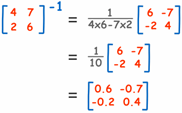
CATEGORIES:
BiologyChemistryConstructionCultureEcologyEconomyElectronicsFinanceGeographyHistoryInformaticsLawMathematicsMechanicsMedicineOtherPedagogyPhilosophyPhysicsPolicyPsychologySociologySportTourism
Inverse of a Matrix
Please read our Introduction to Matrices first.
What is the Inverse of a Matrix?
The Inverse of a Matrix is the same idea as the reciprocal of a number:

Reciprocal of a Number
But we don't write 1/A (because we don't divide by a Matrix!), instead we write A-1 for the inverse:

(In fact 1/8 can also be written as 8-1)
And there are other similarities:
When you multiply a number by its reciprocal you get 1
8 × (1/8) = 1
When you multiply a Matrix by its Inverse you get theIdentity Matrix (which is like "1" for Matrices):
A × A-1 = I
It also works when the inverse comes first: (1/8) × 8 = 1 and A-1 × A = I
Identity Matrix
Note: the "Identity Matrix" is the matrix equivalent of the number "1":

A 3x3 Identity Matrix
- It is "square" (has same number of rows as columns),
- It has 1s on the diagonal and 0s everywhere else.
- It's symbol is the capital letter I.
The Identity Matrix can be 2×2 in size, or 3×3, 4×4, etc ...
Definition
So we have a definition of a Matrix Inverse ...
The Inverse of A is A-1 only when:
A × A-1 = A-1 × A = I
Sometimes there is no Inverse at all.
X2 Matrix
OK, how do we calculate the Inverse?
Well, for a 2x2 Matrix the Inverse is:

In other words: swap the positions of a and d, put negatives in front of b and c, and divide everything by the determinant (ad-bc).
Let us try an example:

How do we know this is the right answer?
Remember it must be true that: A × A-1 = I
So, let us check to see what happens when we multiply the matrix by its inverse:

And, hey!, we end up with the Identity Matrix! So it must be right.
It should also be true that: A-1 × A = I
Why don't you have a go at multiplying these? See if you also get the Identity Matrix:

Why Would We Want an Inverse?
Because with Matrices we don't divide! Seriously, there is no concept of dividing by a Matrix.
But we can multiply by an Inverse, which achieves the same thing.
Imagine you couldn't divide by numbers, and someone asked "How do I share 10 apples with 2 people?"
But you could take the reciprocal of 2 (which is 0.5), so you could answer:
10 × 0.5 = 5
They get 5 apples each
The same thing can be done with Matrices:
Say that you know Matrix A and B, and want to find Matrix X:
XA = B
It would be nice to divide both sides by A (to get X=B/A), but remember we can't divide.
But what if we multiply both sides by A-1 ?
XAA-1 = BA-1
And we know that AA-1 = I, so:
XI = BA-1
We can remove I (for the same reason we could remove "1" from 1x = ab for numbers):
X = BA-1
And we have our answer (assuming we can calculate A-1)
In that example we were very careful to get the multiplications correct, because with Matrices the order of multiplication matters. AB is almost never equal to BA.
Date: 2015-12-11; view: 1507
| <== previous page | | | next page ==> |
| Calculating the Determinant | | | A Real Life Example |